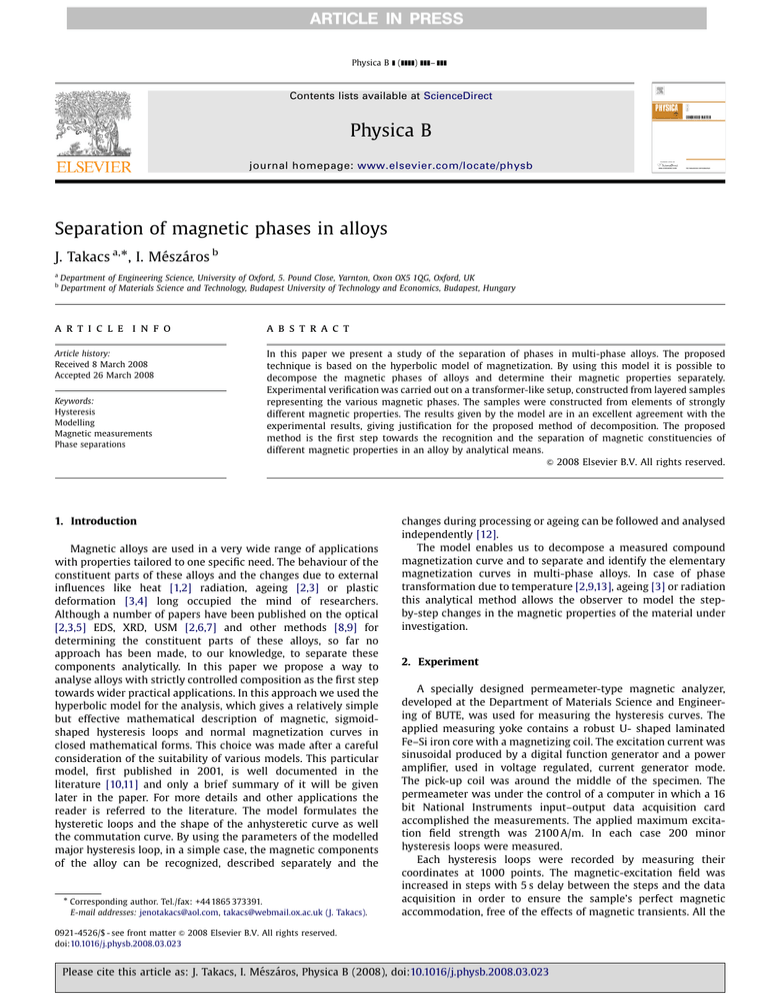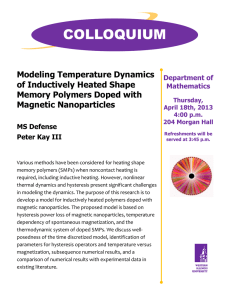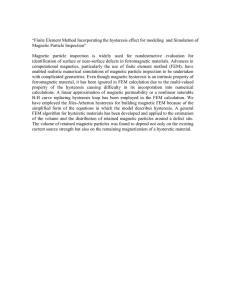
ARTICLE IN PRESS
Physica B ] (]]]]) ]]]– ]]]
Contents lists available at ScienceDirect
Physica B
journal homepage: www.elsevier.com/locate/physb
Separation of magnetic phases in alloys
J. Takacs a,, I. Mészáros b
a
b
Department of Engineering Science, University of Oxford, 5. Pound Close, Yarnton, Oxon OX5 1QG, Oxford, UK
Department of Materials Science and Technology, Budapest University of Technology and Economics, Budapest, Hungary
a r t i c l e in fo
abstract
Article history:
Received 8 March 2008
Accepted 26 March 2008
In this paper we present a study of the separation of phases in multi-phase alloys. The proposed
technique is based on the hyperbolic model of magnetization. By using this model it is possible to
decompose the magnetic phases of alloys and determine their magnetic properties separately.
Experimental verification was carried out on a transformer-like setup, constructed from layered samples
representing the various magnetic phases. The samples were constructed from elements of strongly
different magnetic properties. The results given by the model are in an excellent agreement with the
experimental results, giving justification for the proposed method of decomposition. The proposed
method is the first step towards the recognition and the separation of magnetic constituencies of
different magnetic properties in an alloy by analytical means.
& 2008 Elsevier B.V. All rights reserved.
Keywords:
Hysteresis
Modelling
Magnetic measurements
Phase separations
1. Introduction
Magnetic alloys are used in a very wide range of applications
with properties tailored to one specific need. The behaviour of the
constituent parts of these alloys and the changes due to external
influences like heat [1,2] radiation, ageing [2,3] or plastic
deformation [3,4] long occupied the mind of researchers.
Although a number of papers have been published on the optical
[2,3,5] EDS, XRD, USM [2,6,7] and other methods [8,9] for
determining the constituent parts of these alloys, so far no
approach has been made, to our knowledge, to separate these
components analytically. In this paper we propose a way to
analyse alloys with strictly controlled composition as the first step
towards wider practical applications. In this approach we used the
hyperbolic model for the analysis, which gives a relatively simple
but effective mathematical description of magnetic, sigmoidshaped hysteresis loops and normal magnetization curves in
closed mathematical forms. This choice was made after a careful
consideration of the suitability of various models. This particular
model, first published in 2001, is well documented in the
literature [10,11] and only a brief summary of it will be given
later in the paper. For more details and other applications the
reader is referred to the literature. The model formulates the
hysteretic loops and the shape of the anhysteretic curve as well
the commutation curve. By using the parameters of the modelled
major hysteresis loop, in a simple case, the magnetic components
of the alloy can be recognized, described separately and the
Corresponding author. Tel./fax: +44 1865 373391.
E-mail addresses: jenotakacs@aol.com, takacs@webmail.ox.ac.uk (J. Takacs).
changes during processing or ageing can be followed and analysed
independently [12].
The model enables us to decompose a measured compound
magnetization curve and to separate and identify the elementary
magnetization curves in multi-phase alloys. In case of phase
transformation due to temperature [2,9,13], ageing [3] or radiation
this analytical method allows the observer to model the stepby-step changes in the magnetic properties of the material under
investigation.
2. Experiment
A specially designed permeameter-type magnetic analyzer,
developed at the Department of Materials Science and Engineering of BUTE, was used for measuring the hysteresis curves. The
applied measuring yoke contains a robust U- shaped laminated
Fe–Si iron core with a magnetizing coil. The excitation current was
sinusoidal produced by a digital function generator and a power
amplifier, used in voltage regulated, current generator mode.
The pick-up coil was around the middle of the specimen. The
permeameter was under the control of a computer in which a 16
bit National Instruments input–output data acquisition card
accomplished the measurements. The applied maximum excitation field strength was 2100 A/m. In each case 200 minor
hysteresis loops were measured.
Each hysteresis loops were recorded by measuring their
coordinates at 1000 points. The magnetic-excitation field was
increased in steps with 5 s delay between the steps and the data
acquisition in order to ensure the sample’s perfect magnetic
accommodation, free of the effects of magnetic transients. All the
0921-4526/$ - see front matter & 2008 Elsevier B.V. All rights reserved.
doi:10.1016/j.physb.2008.03.023
Please cite this article as: J. Takacs, I. Mészáros, Physica B (2008), doi:10.1016/j.physb.2008.03.023
ARTICLE IN PRESS
2
J. Takacs, I. Mészáros / Physica B ] (]]]]) ]]]–]]]
sigmoid-type loops of the individual components, by using
Maxwell’s superposition principle. This supposition was put to
the test by using the hyperbolic model. This model facilitates the
linear superposition of the individual sigmoid loops and indeed
provides the way to separate the simple phases and/or the
different parallel magnetic processes acting in an alloy during
magnetization.
The model itself is well described in the literature and here
only a brief summary of the formulation will be given [10,11]. In
an alloy, the contribution of the individual phases to the combined
hysteresis loop can be described by the following mathematical
equations in normalized form:
measurements were carried out by using sinusoidal excitation at a
frequency of 5 Hz. Due to the relatively low excitation frequency
and the small thickness of the samples (0.35–0.5 mm), the
completed magnetic measurements should be regarded as
pseudo-static. The effect of eddy-current on the magnetization
curves were negligibly small, well within the measuring error.
The permeameter enabled us to obtain all the practical
magnetic parameters such as the saturation induction, remanence, coercivity, relative permeability and hysteretic losses,
directly from the measured hysteresis loops.
For testing the model for the magnetic phase decomposition,
special-layered test objects were constructed out of six, selected
elementary samples (identified as S4, S6, S8, S11, S13 and S17),
made of structural steels and a permalloy. All the selected samples
had simple sigmoid-like hysteresis loops. The coercivity values
and geometrical details of each layer samples are summarized in
Table 1.
The magnetization curves of each of the component material
were measured separately for reference purposes. Following that,
a number of layered test samples were built with the combination
of the different laminae. The phases were represented in the
experiment by the laminated material of known character,
composed into different combinations. The volume ratios of the
components, present in the experimental samples were calculated
from the geometry and the number of layers. After that, the details
of the measured hysteresis curves passed on for analysis with the
identity and the properties of the layered samples concealed. Then
each of the major loops were modelled and decomposed to their
constituent parts. The magnetic properties and the hysteresis
loops of all component parts were recorded and the volume ratio
calculated.
yþn ¼
n
X
ðAk f þk þ bn Þ
(1a)
k¼1
yn ¼
n
X
ðAk f k bn Þ
(1b)
k¼1
f þk ¼ tanh½ak ðx a0k Þ
(2a)
f k ¼ tanh½ak ðx þ a0k Þ
(2b)
bn ¼
n
1X
A ðf f þk Þ
2 k¼1 k k
for x ¼ xm
(3)
The model is characterized by the practical parameters used in
magnetism. Here y+n and yn are the normalized ascending and
descending magnetization functions, respectively, x is the field
excitation, a0k is the coercivity of the kth process. Ak is the
amplitude of the components present, ak is the sheering factor and
bn is the integration constant [14], while xm represents the
maximum field excitation. The index k refers to the individual
component phases and n is the number of total magnetic
components involved. For most of the magnetic materials, used
in practical application n equals 3. Ferro-magnetic materials,
specially made or selected for purity, have only single sigmoidtype character. In the elementary samples, used in this experiment, the existence of one irreversible phase and a very small
content of nearly reversible phase were found, which made up
their hysteretic properties (see Tables 1 and 2).
3. Model description
The analytical approach described here was based on the initial
assumption that, when an alloy contains two or more magnetic
metallurgical phases they are not interacting magnetically, therefore their magnetization curves can be linearly superimposed.
From this, it has followed, that in a simple case the hysteresis loop
of an alloy can be composed by linear superposition of the
Table 1
Measured-coercivity values and cross sections of the elementary samples
Sample name
Description
Measured coercive field (A/m)
Cross section (mm2)
S4
S6
S8
S11
S13
S17
Low carbon steel (AISI 1010) annealed
Medium carbon steel (AISI 1050) cold rolled
High carbon steel (AISI 1074) cold rolled
Permalloy (Fe-76%Ni) cold rolled
Medium carbon steel (AISI 1050) annealed
High carbon steel (AISI 1080) normalized
266
308
555
172
336
513
15.28
15.28
20.13
9.7
6.35
7.98
(2 6 5)
(3 0 1)
(5 6 7)
(1 6 5)
(3 2 1)
(5 0 3)
Table 2
Experimental and calculated coercivity (Hc) and remanence (Br) values for the combinations of the elementary samples shown
Alloy
Hc A/m
Hc1 Hc1 A/m
Hc2 Hc2 A/m
S6+S17
S4+S17
S6+S8
S11+S13
2xS11+S13
Exp.
Calc.
Exp.
Calc.
Exp.
Calc.
Exp.
Calc.
Exp.
Calc.
365
308
513
368
305
503
322
266
513
333
289
510
400
308
555
400
302
550
236
172
336
240
180
328
208
172
336
214
181
397
Br T
1.51
1.5
1.4
1.37
1.5
1.5
1.2
1.1
1
0.95
A1/A2
1.91
2.1
1.91
1.89
1.31
1.65
1.53
1.66
3.1
3.05
Please cite this article as: J. Takacs, I. Mészáros, Physica B (2008), doi:10.1016/j.physb.2008.03.023
ARTICLE IN PRESS
J. Takacs, I. Mészáros / Physica B ] (]]]]) ]]]–]]]
3
4. Test results
In this blind test, out of the six selected samples, the prepared
layered structures were the following combinations of the
elementary samples: S6+S17, S4+S17, S6+S8, S11+S13 and
2xS11+S13.
Not until all the relevant parameters were calculated from the
fitted loops and the two sets, of data (experimental and
calculated) were compared was the test sample identified.
The fitted hysteresis loops provided the coercivity and
remanence values and also allowed us to determine the relative
volume of the elementary components in the alloy and the
relative magnitudes of the hysteresis loops of the component
phases.
The measured and calculated coercivity of the combined (Hc)
and the component hysteresis loops ðHc1 ; Hc2 Þ with the associated
remanence (Br) as well as the volume ratio (A1/A2) of the two
major components are tabulated in Table 2.
Fig. 1 depicts the measured and fitted-combined hysteresis
loops of the experimental sample S6+S8.
Fig. 2 shows the calculated constituent loops with the
combined loop. These are shown as a representative set, out of
the five combined sets measured in the experiment. The modelled
Fig. 1. Measured (broken line) and calculated (solid line) hysteresis loops of
combined sample S6+S8.
Fig. 3. Measured (broken line) and calculated (solid line) reference hysteresis
loops; (a) elementary component S6, (b) elementary component S8 and (c) near
reversible component.
Fig. 2. The calculated combined and constituent loops.
Please cite this article as: J. Takacs, I. Mészáros, Physica B (2008), doi:10.1016/j.physb.2008.03.023
ARTICLE IN PRESS
4
J. Takacs, I. Mészáros / Physica B ] (]]]]) ]]]–]]]
loops have been calculated by using Eqs. (1a),(1b),(2a),(2b) and
(3) with parameters of the following normalized and physical
values: A1 ¼ 0.825 ¼ 0.891 T, A2 ¼ 0.5 ¼ 0.54 T, A3 ¼ 0.325 ¼ 0.4 T,
a1 ¼ 0.83, a2 ¼ 0.55, a3 ¼ 0.042, a01 ¼ 3 ¼ 302 A/m, a02 ¼
5.5 ¼ 553 A/m, a03 ¼ 6 ¼ 603 A/m. Figs. 3a and b show the
reference hysteresis loops of the elementary samples S6 and S8
fitted with the loops calculated with the same ak, a0k and xm
parameters. The agreement between the elementary reference
and the calculated loops is unexpectedly good as one can see from
Fig. 3.
An identical underlying component (A3, a3, a03) present in all
samples, shown in Fig. 3c, having a near reversible character, is
not listed in Table 1. Its presence shows up in the slight inclination
of the hysteresis loop (see Fig. 2) near saturation. Its shearing
coefficient is an order of magnitude smaller than that of the other
two. Due to this, its effect on the characteristic parameters of the
test sample is negligibly small relative to that of the other two
larger strongly hysteretic components.
5. Discussion and conclusions
The blind test, carried out on a number of well-controlled
samples, demonstrated that the proposed method by using the
hyperbolic model could be used for separation of the magnetic
phases in alloys. The initial assumption, that in a non-interacting
case the elementary components can be identified and their
magnetic properties correctly calculated is well proven. The
experiment has also proved that all the practical magnetic
parameters such as the coercivity, remanence, the volume ratio
and the hysteresis loops of the individual contributory elements,
can be calculated with very good accuracy. Although the accuracy
achieved so far seems acceptable in most practical applications,
further experiments are in progress to improve it and also to use
this method for decomposition of other elementary magnetic
materials with various combinations. Further investigations will
cover composites with more than one magnetic process, deviating
from the sigmoid character. This method, described here, could
become an important tool in practical tests, particularly in
investigating phase transitions as well as in theoretical investigations in magnetism.
References
[1] S. Chatterjee, S. Giri, S. Majumdar, S.K. De, J. Magn. Magn. Mater. 320 (2008)
617.
[2] K.H. Lo, J.K.L. Lai, C.H. Shek, D.J. Li, Mater Sci. Eng. A 452–453 (2007) 149.
[3] K.H. Lo, J.K.L. Lai, C.H. Shek, D.J. Li, Mater Sci. Eng. A 452–453 (2007) 78.
[4] Y.D. Zhang, C. Esling, M.L. Gong, G. Vincent, X. Zhao, L. Zuo, Scri. Mater. 54
(2006) 1897.
[5] S.P. Sagar, B.R. Kumar, G. Dobman, D.K. Bhattacharya, NDT E Int. 38 (2005)
674.
[6] S. Groudeva-Zotova, H. Karl, A. Savan, J. Feydt, B. Wehner, T. Walther, N. Zotov,
B. Stritzker, A. Ludwig, Thin Solid Films 495 (2006) 169.
[7] S.K. Putatunda, S. Unni, G. Lawes, Mater. Sci. Eng. A 406 (2005) 254.
[8] A. Senas, J.I. Espeso, J.R. Fernandez, J.G. Soldevilla, J.C.G. Sal, J.R. Carvajal,
R. Ibarra, Physica B 276–278 (2000) 614.
[9] J.S. Blasquez, V. Franco, C.F. Conde, J. Ferenc, T. Kulik, Mater. Lett. 62 (2008)
780.
[10] J. Takacs, Mathematics of Hysteresis Phenomena, Wiley-VCH Verlag, Weinheim, 2003.
[11] J. Takacs, COMPEL 20 (4) (2001) 1002.
[12] L.K. Varga, Gy. Kovács, J. Takács, Anhysteretic and biased first magnetization
curves for Finemet type toroidal samples, J. Magn. Magn. Mater (2008) in
press, doi:10.1016/j.jmmm.2008.04.135.
[13] J. Takács, Gy. Kovács and L.K. Varga. Decomposition of the hysteresis loops
of nanocrystalline alloys below and above the decoupling temeperature.
J. Magn. Magn. Mater (2008) in press.
[14] J. Takács, Physica B 372 (1–2) (2006) 57.
Please cite this article as: J. Takacs, I. Mészáros, Physica B (2008), doi:10.1016/j.physb.2008.03.023



